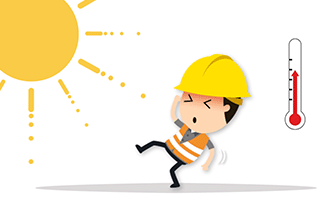Heat Stress
The exposure to heat can cause illness and severe health concerns to employees especially those who working in outdoor jobs. The most serious heat illness is heat stroke. Other heat illnesses, such as heat exhaustion, heat cramps and heat rash, should also be avoided, the following measures and precautions to be considered.
1.Understand
that heat stress is a normal physical condition which is caused by any physical
exertion. However, when employees directly exposed to sunrays, temperatures can
exceed 50 ºC (120 ºF), which may lead to other adverse health effects because of
this exposure.
2. Drinking
enough water - Heat exhaustion can occur if an employee becomes too hot,
expends too much energy, and does not drink enough required water for the body.
Heat exhaustion is generally not dangerous and the symptoms are:
2.1. Profuse Sweating. 2.2. Nausea. 2.3. Dizziness2.4. Muscle cramps, generally in the legs & abdomen are the general symptoms.
Workplace Risk Assessment: A Key Step in Improving Safety
3. Employee
should be training in basic first aid and the First Aid for heat exhaustion is:
3.1. Help
the employee to lay down in the shade or air-conditioned area for the body
temperature control.
3.2. Provide
enough water - Give in small quantities every 2 to 3 minutes until the employee
recovers.
3.3. Call
for support from the Medical Facilities.
3.4. Remember
- DO NOT gives salt or ice.
3.5. Instead
apply cool water to the back of the neck and wrist.
4. Heat
stroke is potentially life threatening and it occurs very rare, Heat stroke may
occur after heat exhaustion has set in and has the below symptoms.
4.1. The body
of the sufferer stops sweating but is very hot to the touch.
4.2. The employee
will be disoriented or may become unconscious.
4.3. The employee generally will suffer condition of heat exhaustion prior to heat stroke effects.
Safety Training Videos with Pictorial Guidelines
5. The
basic First Aid for heat stroke is:
5.1. Call
for company/local medical assistance immediately.
5.2. Move
the sufferer into shade or air-conditioned area for the body temperature
control.
5.3. If
available, Pack the ice, around the sufferers wrists, under the arms, and groin
area. If ice is not available, use water.
5.4. If the
sufferer is conscious give small amounts of water to drink every 2 to 3
minutes.
5.5. Remove
clothing of the employee in the chest to torso.
5.6. Remember
- Do not allow stroke sufferer to swallow ice and DO NOT give salt.
6. Keep the sufferer calm and wait for the medical assistance to arrive for the medical support to the employee.

No comments:
Post a Comment